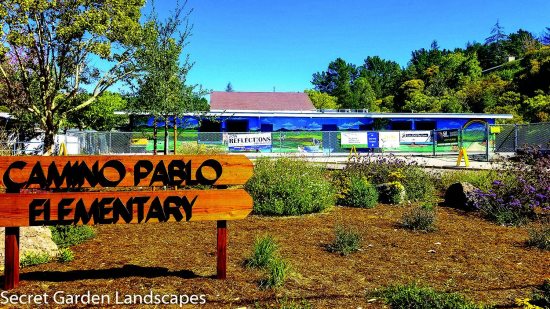
| ||||||
Habitat gardens are generally characterized by a more natural aesthetic with a wide variety of plants that specifically add positive benefits to the environment. Native plants provide an unrivaled habitat because native flora and fauna have co-evolved over thousands of years.
Laura Osteen, Moraga resident and owner of Secret Garden Landscapes, incorporates habitat gardening into all of her designs. She especially enjoys educating her clients about the importance of habitat creation for wildlife like pollinators. "By promoting pollinators' needs for habitat, we are supporting our own need for food and diversity in the natural world," Osteen says. By creating habitats for pollinators, we enable them to fertilize plants. Only then can the plants produce fruits, nuts, or seeds that humans need for a healthy diet.
One prominent example of her habitat gardening design is at Camino Pablo Elementary School in Moraga. Back in 2016, landscape improvements were already underway at the school. A group of parents, lead by Shweta Srivastava and Tammy Roake, had created a beautiful mural across the entire front wall of the school, capturing the beauty of the surrounding Moraga hills. "It felt like a shame to leave the front circle as-is with its overgrown juniper and chain-linked fence," they said. And so the gardening project launched to complement the mural, extending the natural habitat into the landscape.
The habitat garden was installed on Earth Day 2017, with the help of the Camino Pablo community. Parents and students (including a handful of Boy Scout and Girl Scout troops) worked together to dig holes, level soil, lay gold fine dust, stack moss rock and mulch.
The new Camino Pablo front circle is focused on pollinator plants like California poppies, verbena, salvia, rudbeckia, and California lilac. As people drive by at different times throughout the year, the garden is constantly evolving. While in winter many of the flowers are dormant, the plants are still providing places for wildlife to forage. And plants like manzanita bloom in late winter, providing food for hummingbirds.
As the seasons change, various plants provide pollination, food for birds and butterfly larvae, material for birds' nests, spaces for butterflies to lay eggs, and places for wildlife to hide.
Osteen also planted a California Native Oak in the circle, which aids wildlife in many ways, like providing food (acorns), shade, and habitat. In addition, since Oaks are slow-growing, she thought the Camino Pablo graduates would enjoy coming back years later and seeing the change in the tree's size. "It helps provide a symbol associated with their own growth from childhood," she explains.
In summer 2018, the wooden "Camino Pablo Elementary" sign was installed by Boy Scout Troop 246, led by Kellen Clancy, who gained his Eagle Scout rank from creation and installation of the sign. The wood sign blends in with the aesthetic of the native landscape and mural as well.
As spring approaches and residents contemplate new home outdoor landscaping, consider supporting wildlife by bringing back some of their native resources in your home garden. "When a landscape becomes `alive' it is so much more enjoyable. Plus, it teaches children to value our natural environment around us," Osteen highlights. When she designs home gardens, her goal is to create beautiful, sustainable, and functional landscapes that meets her clients' unique styles.
Reach the reporter at:
